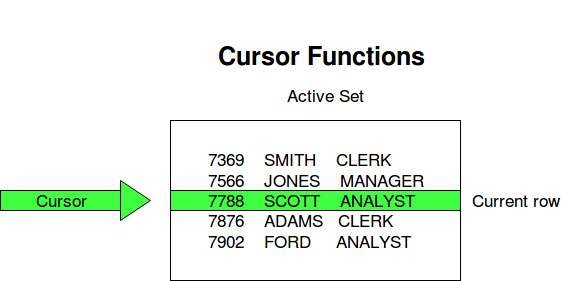There are different items such as java C that can be saved in a relational database using object-oriented programming languages but object-oriented databases are suitable for these components. My All DBMS SL1 Assignments TEIT SPPU.

What Is Cursor Types Of Cursors And Their Attributes Of Cursors In Oracle Plsql Youtube
Dynamic Cursors A dynamic cursor allows you to see the data updation deletion and insertion in the data source while.

. - The oracle engine implicitly opens a cursor on the server to process each SQL statement. DYNAMIC changes made are reflected in the. Primary Key - The primary key is selected from one of the candidate keys and becomes the identifying key of a tableIt can uniquely identify any data row of the table.
Types of Cursors Static Cursors A static cursor populates the result set at the time of cursor creation and the query result is cached. A cursor contains information on a select statement and the rows of data accessed by it. These cursors are created.
There are two types of cursors. A cursor holds the rows one or more returned by a SQL statement. There are 2 types of Cursors.
This cursor functionality lies between a static and a dynamic cursor regarding its ability to detect changes. Type t_refcursor2 is ref cursor return return_type. These functions are created by user in the system database and we have 3 types of user define functions.
Programmer will not have control on implicit cursors. Types of Cursors STATIC any changes made arent reflected in the cursors results. Explain different types of cursors.
Explicit Cursors user defined cursor. More details available at my blog. In this type of cursors developer will.
DBMS SL1 Assignments. These are explained as following below. These cursors are created by the developer in his program.
There are two types of cursors. These are the cursors which are automatically created and used by the DBMS. Count This will return number of counts.
An object-driven database is an object-driven and relational database collection. Used mostly where scrolling is required. User need not create open fetch or close the cursor.
These cursors are not invoked implicitly. Multi Statement Table-Valued Function. It has to be defined in the.
MongoDB CouchDB Graph. An explicit cursor requires a declaration by the user by the use of the SELECT statement. Each time you fetch a row from the cursor it results in a network roundtrip.
Implicit Cursors are also known as Default Cursors of SQL SERVER. A cursor is used to referred to a program to fetch and process the rows returned by the SQL statement one at a time. Once the reading of one row is complete it moves to another row.
Description An exploration into the different ways you can define and use cursors pointers to SQL result sets in PLSQL including. Forward Only Cursors A forward only. Lets open both cursor variables and fetch information from the first record and finally close the cursors.
Implicit cursor explicit cursor cursor expressions cursor variables DBMS_SQL cursor handles. Candidate Key - The candidate keys in a table are defined as the set of keys that is minimal and can uniquely identify any data row in the table. Study and design a database with suitable example using following database systems.
The set of rows the cursor holds is referred to as the active set. User needs to create open fetch or close the cursor. You can name a cursor so that it could be referred to in a program to fetch and process the rows returned by the SQL statement one at a time.
Riak Redis Columnar. There are mainly 2 types of cursors. Sum This will return total sum of numeric value.
Cursors in DBMS Definition Types Attributes Uses. Cursors in DBMS Implicit Cursors. Different Types of Cursors in PLSQL.
Cursors are used to store Database Tables. One of the examples of implicit cursor. - Explicit Cursors are the cursors created by the user inside a.
The Forward-Only cursors are three categorize into three types. Implicit cursors predefined cursor. Lets see an example see Listing 14.
The only useful attribute on this implicit cursor is SQL ROWCOUNT it will give the. Oralce will implicitly creates an area for the DML operations. Different types of cursors.
There are two types of cursors in PLSQL. Also any change made to the cursors data arent. Stores a complete copy of the result set.
It goes over each record but only a single row is processed at a time. Where as a normal SELECT query makes only one roundtrip however large the resultset is. SQL PostgreSQL MySQL Key-value.
Static Dynamic Forward-only Keyset-driven. Explicit cursors are defined by the programmers to have more control area on the context area. There are 2 types of Cursors used in PLSQL programming.
Lets define a weak cursor generic cursor and strong cursor which expects to receives records from the table emp. Implicit Cursors As the name indicates Implicit cursors are those cursors that are automatically created by. A cursor is a handle pointer in memory for a DML operation Select Update.
An implicit cursor is put internally by SQL whenever the user runs any DML query. Type t_refcursor1 is ref cursor. Implicit cursors are managed by the Oracle engine itself.
These cursors are invoked implicitly. Cursors allow row-by-row processing of the resultsets. The different types of keys in DBMS are.
KEYSET A keyset cursor can see changes made to rows that are originally in to cursor since these rows unique. It cant always detect changes in the result sets membership and order like a static cursor. These Cursors are allocated by SQL SERVER when the user performs DML operations.
Implicit Cursors and Explicit Cursors.

Cursors In Pl Sql Geeksforgeeks

Cursors In Pl Sql Different Types Of Cursors In Pl Sql Used In Oracle

Cursors In Dbms Definition Types Attributes Uses Geeksforgeeks
0 Comments